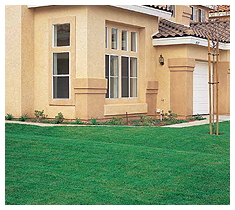Blue Ryegrass in California
A year-round dark green color and fine texture
A combination of improved Kentucky Bluegrass and perennial ryegrass suited to the West. This blend provides a year-round dark green color, fine texture and a lushness and appeal unequaled by other grasses. The natural rhizome structure of bluegrass will fill in and repair damaged grass areas.
General Rating
- Drought Tolerance
- Disease Resistance
- Wear Resistance
- Shade Tolerance
- Winter Color
- Heat Tolerance
Available at these farms
Maintenance Guide
Technical Data
Technical Data |
|
|
Common Name |
Bluerye |
|
Species |
Kentucky Bluegrass/Perennial Ryegrass Blend |
|
Growth Rate |
Summer 3/4 to 1 1/4 inches per week |
|
Root Depth |
3 to 5 feet, depending upon soil type and watering patterns. |
Adaptability |
|
|
Soils Range |
Fair tolerance to saline soil conditions. |
|
Temperature Tolerance |
0°F. to 110°F. |
|
ET0 |
.6 minimum, .8 preferred |
|
pH Range |
5.0 to 8.5, 7.0 optimum |
|
Shade Tolerance |
Prefers full sun, but tolerates 40% shade. |
|
Geographic Range |
(Refer to temperature tolerance above.) |
Standards and Measures |
|
|
Size |
5 to 10 sq. ft. per piece, depending upon market |
|
Big Rolls |
200 to 500 sq. ft. |
|
Soil Thickness |
1/2 inch +/- 1/8 inch + top growth |
|
Weight |
2,500 to 3,000 lbs. per pallet |
|
Seed Rate |
2 to 3 lbs. per 1000 sq. ft. |
|
Other |
– 100% Weed Free Sod |
Ready to order? Have a few questions?
Contact the farm nearest you.
Moreno Valley, CA
800-233-5254
Palmdale, CA
800-669-4763
Fresno, CA
888-800-8483
Stockton, CA
800-588-6882
Fort Collins, CO
970-482-6574
